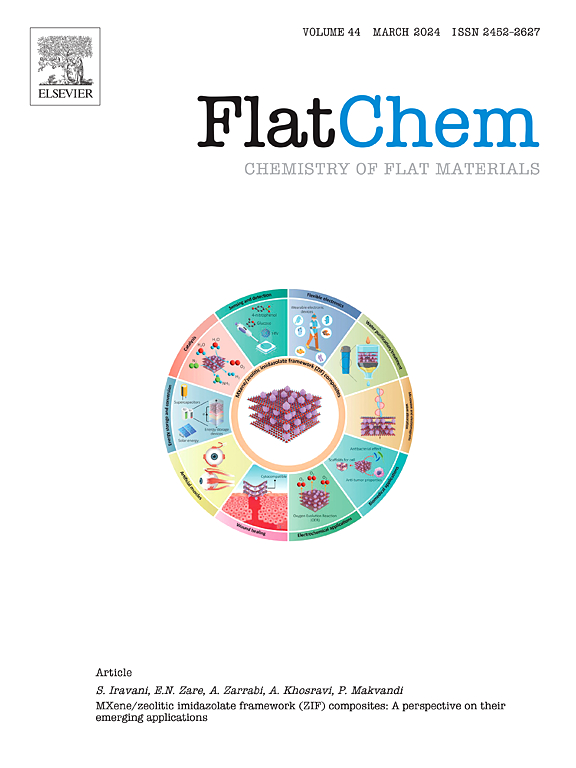氧化石墨烯/PSBMA纳滤膜的电荷尺寸协同筛选:用于染料脱盐和防污机理研究
IF 6.2
3区 材料科学
Q2 CHEMISTRY, PHYSICAL
引用次数: 0
摘要
设计了一种新型氧化石墨烯(GO)纳滤膜,以解决含盐纺织废水中染料和无机盐的选择性分离问题。高度亲水性的甲基丙烯酸磺基甜菜碱(SBMA)被共价接枝到氧化石墨烯表面,以制备两性聚合物纳米片(PSBMA@GO)。随后用原始氧化石墨烯纳米片进行物理插层,得到了GPM1:2复合膜。该策略有效地扩大了层间通道,使膜的渗透率显著提高,达到31.53 L·m−1 h−1 bar−1,明显超过原始氧化石墨烯膜(12.26 L·m−1 h−1 bar−1)。两性离子修饰保留了氧化石墨烯固有的负电荷。膜表面电荷调节和精确的孔径控制之间的协同作用实现了优异的染料/盐分离选择性。对亚甲蓝(MnB)和刚果红(CR)的去除率分别超过99.47%和98.7%。同时,促进了单/二价盐离子的高效渗透(NaCl: 96.83%; Na₂SO₄:95.8%)。此外,两性离子聚合物具有优异的抗污染性能,在牛血清白蛋白(BSA)污染后的通量回收率(FRR)高达89.15%。即使经过严格的10小时动态循环测试,FRR仍保持在80%以上。本研究通过界面功能化和结构调节的协同优化,为设计高效染料废水处理膜建立了新的范式。本文章由计算机程序翻译,如有差异,请以英文原文为准。

Charge-size synergistic screening of GO/PSBMA nanofiltration membranes: for dye desalination and anti-fouling mechanism studies
A novel graphene oxide (GO)-based nanofiltration membrane was engineered to tackle the selective separation challenge of dyes and inorganic salts in salt-laden textile wastewater. Highly hydrophilic sulfobetaine methacrylate (SBMA) was covalently graft-polymerized onto GO surfaces to fabricate amphoteric polymer nanosheets (PSBMA@GO). Subsequent physical intercalation with pristine GO nanosheets yielded the GPM1:2 composite membrane. This strategy effectively enlarged the interlayer channels, endowing the membrane with a significantly enhanced permeability of 31.53 L·m−1 h−1 bar−1, markedly surpassing that of the pristine GO membrane (12.26 L·m−1 h−1 bar−1). The zwitterionic modification preserved the inherent negative charge of GO. The synergistic interplay between membrane surface charge regulation and precise pore size control achieved exceptional dye/salt separation selectivity. Dyes were selectively rejected via the Donnan exclusion effect, with rejection rates for Methylene Blue (MnB) and Congo Red (CR) exceeding 99.47 % and 98.7 %, respectively. Concurrently, efficient permeation of mono/divalent salt ions was facilitated (NaCl: 96.83 %; Na₂SO₄: 95.8 %). Furthermore, the zwitterionic polymer conferred exceptional anti-fouling properties, evidenced by a high flux recovery rate (FRR) of 89.15 % following bovine serum albumin (BSA) fouling. The FRR remained above 80 % even after a rigorous 10-h dynamic cycling test. This study establishes a novel paradigm for designing high-efficiency dye wastewater treatment membranes through the synergistic optimization of interfacial functionalization and structural modulation.
求助全文
通过发布文献求助,成功后即可免费获取论文全文。
去求助
来源期刊

FlatChem
Multiple-
CiteScore
8.40
自引率
6.50%
发文量
104
审稿时长
26 days
期刊介绍:
FlatChem - Chemistry of Flat Materials, a new voice in the community, publishes original and significant, cutting-edge research related to the chemistry of graphene and related 2D & layered materials. The overall aim of the journal is to combine the chemistry and applications of these materials, where the submission of communications, full papers, and concepts should contain chemistry in a materials context, which can be both experimental and/or theoretical. In addition to original research articles, FlatChem also offers reviews, minireviews, highlights and perspectives on the future of this research area with the scientific leaders in fields related to Flat Materials. Topics of interest include, but are not limited to, the following: -Design, synthesis, applications and investigation of graphene, graphene related materials and other 2D & layered materials (for example Silicene, Germanene, Phosphorene, MXenes, Boron nitride, Transition metal dichalcogenides) -Characterization of these materials using all forms of spectroscopy and microscopy techniques -Chemical modification or functionalization and dispersion of these materials, as well as interactions with other materials -Exploring the surface chemistry of these materials for applications in: Sensors or detectors in electrochemical/Lab on a Chip devices, Composite materials, Membranes, Environment technology, Catalysis for energy storage and conversion (for example fuel cells, supercapacitors, batteries, hydrogen storage), Biomedical technology (drug delivery, biosensing, bioimaging)
 求助内容:
求助内容: 应助结果提醒方式:
应助结果提醒方式:


